Related Research Articles
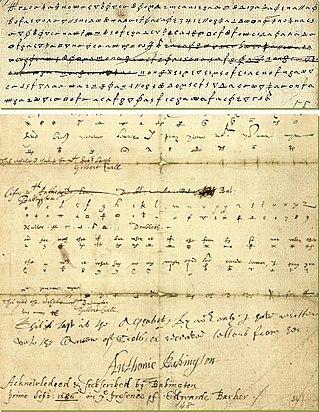
The Babington Plot was a plan in 1586 to assassinate Queen Elizabeth I, a Protestant, and put Mary, Queen of Scots, her Catholic cousin, on the English throne. It led to Mary's execution, a result of a letter sent by Mary in which she consented to the assassination of Elizabeth.

The French Wars of Religion were a series of civil wars between French Catholics and Protestants from 1562 to 1598. Between two and four million people died from violence, famine or disease directly caused by the conflict, and it severely damaged the power of the French monarchy. One of its most notorious episodes was the St. Bartholomew's Day massacre in 1572. The fighting ended with a compromise in 1598, when Henry of Navarre, who had converted to Catholicism in 1593, was proclaimed King Henry IV of France and issued the Edict of Nantes, which granted substantial rights and freedoms to the Huguenots. However, Catholics continued to disapprove of Protestants and of Henry, and his assassination in 1610 triggered a fresh round of Huguenot rebellions in the 1620s.
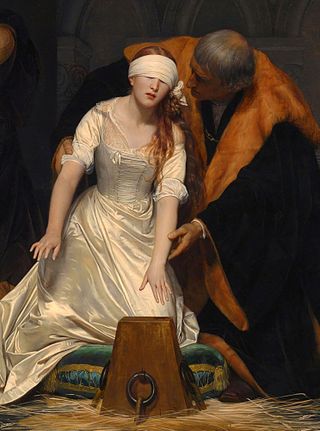
Regicide is the purposeful killing of a monarch or sovereign of a polity and is often associated with the usurpation of power. A regicide can also be the person responsible for the killing. The word comes from the Latin roots of regis and cida (cidium), meaning "of monarch" and "killer" respectively.
Sir William Stanley, son of Sir Rowland Stanley of Hooton and Margaret Aldersy, was a member of the Stanley family, Earls of Derby. He was an officer and a recusant, who served under Elizabeth I of England and is most noted for his surrender of Deventer to the Spanish in 1587.
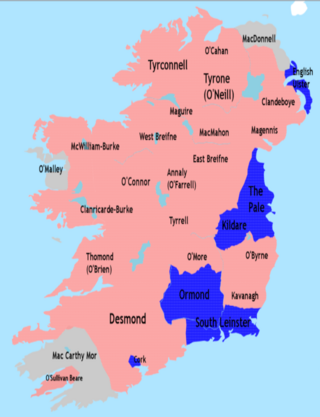
The Nine Years' War, sometimes called Tyrone's Rebellion, took place in Ireland from 1593 to 1603. It was fought between an Irish confederacy—led mainly by Hugh O'Neill of Tyrone and Hugh Roe O'Donnell of Tyrconnell—against English rule in Ireland, and was a response to the ongoing Tudor conquest of Ireland. The war began in Ulster and northern Connacht, but eventually engulfed the entire island. The Irish alliance won numerous victories against the English forces in Ireland, such as the Battle of Clontibret (1595) and the Battle of the Yellow Ford (1598), but the English won a pivotal victory against the alliance and their Spanish allies in the siege of Kinsale (1601–02). The war ended with the Treaty of Mellifont (1603). Many of the defeated northern lords left Ireland to seek support for a new uprising in the Flight of the Earls (1607), never to return. This marked the end of Gaelic Ireland and created the groundwork for the foundation of the Plantation of Ulster.
Finnin MacCarthy (1560–1640), was an Irish clan chief and member of the Gaelic nobility of Ireland of the late 16th-century and the last credible claimant to the Mac Carthaig Mór title before its suppression by English authority. Mac Carthaig's involvement in the Nine Years' War (1595–1603) led to his arrest by the Crown, and he spent the last 40 years of his life in custody in London. His clan's lands were divided among his relatives and Anglo-Irish colonialists.

Antonio Pérez del Hierro was a Spanish statesman and secretary of king Philip II of Spain.
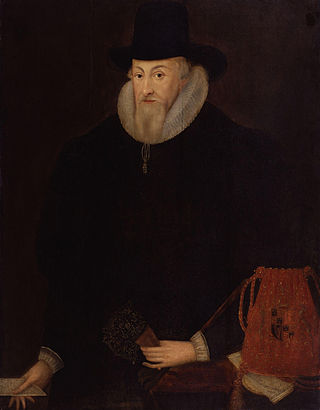
Thomas Egerton, 1st Viscount Brackley,, known as Lord Ellesmere from 1603 to 1616, was an English nobleman, judge and statesman from the Egerton family who served as Lord Keeper and Lord Chancellor for twenty-one years.

Samuel Fraunces was an American restaurateur and the owner/operator of Fraunces Tavern in New York City. During the Revolutionary War, he provided for prisoners held during the seven-year British occupation of New York City (1776-1783), and claimed to have been a spy for the American side. At the end of the war, it was at Fraunces Tavern that General George Washington said farewell to his officers. Fraunces later served as steward of Washington's presidential household in New York City (1789–1790) and Philadelphia (1791–1794).

Ferdinando Stanley, 5th Earl of Derby, was an English nobleman and politician. He was the son of Henry Stanley, 4th Earl of Derby, and Lady Margaret Clifford. Ferdinando had a place in the line of succession to Elizabeth I according to the will of Henry VIII, after his mother, whom he predeceased. His sudden death led to suspicions of poisoning amid fears of Catholic plots to overthrow Elizabeth.

Roderigo Lopes served as a physician-in-chief to Queen Elizabeth I of England from 1581 until his death by execution, having been found guilty of plotting to poison her. A Portuguese converso or New Christian of Jewish ancestry, he is the only royal doctor in English history to have been executed, and may have inspired the character of Shylock in Shakespeare's The Merchant of Venice, which was written within four years of his death.
Thomas Hickey was a Continental Army soldier in the American Revolutionary War, and the first person to be executed by the Continental Army for "mutiny, sedition, and treachery".
James Archer (1550–1620) was an Irish Roman Catholic priest of the Society of Jesus who played a highly controversial role in both the Nine Years War and in the military resistance to both the House of Tudor's religious persecution of the Catholic Church in Ireland and the Elizabethan wars against both Gaelic Ireland and the Irish clans. During the final decade of the reign of Queen Elizabeth I, Archer became a leading figure of hate in the anti-Catholic propaganda of the English government, but his most lasting achievement was his role in the establishment and strengthening of the Irish Colleges in Catholic Europe during the Counter-Reformation.
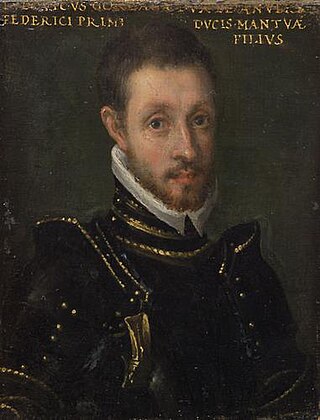
Louis de Gonzague, Duke of Nevers was a soldier, governor and statesman during the French Wars of Religion. His father and brother were reigning dukes of Mantua. He came to France in 1549, and fought for Henri II of France during the latter Italian Wars, getting himself captured during the battle of Saint Quentin. Due to his Italian connections he was seen as a useful figure to have as governor of French Piedmont, a post he would hold until Henri III ceded the territory in 1574. In 1565 his patron, Catherine de' Medici secured for him a marriage with the key heiress Henriette de Clèves, elevating him to duke of Nevers and count of Rethel. He fought for the crown through the early wars of religion, receiving a bad injury in the third war. At this time he formed a close bond with the young Anjou, future king Henri III, a bond that would last until the king's death.

Henry III of Navarre's succession to the throne in 1589 was followed by a war of succession to establish his legitimacy, which was part of the French Wars of Religion (1562–1598). Henry IV inherited the throne after the assassination of Henry III, the last Valois king, who died without children. Henry was already King of Navarre, as the successor of his mother, Jeanne d'Albret, but he owed his succession to the throne of France to the line of his father, Antoine of Bourbon, an agnatic descendant of Louis IX. He was the first French king from the House of Bourbon.
William Holt (1545–1599) was an English Jesuit and conspirator, who organised several unsuccessful plots to assassinate Elizabeth I.

Owen MacCarthy Reagh (1520–1594) was the 16th Prince of Carbery from 1576 to 1593. He belonged to the MacCarthy Reagh dynasty. Owen was commonly referred to as "Sir" Owen MacCarthy (McCartie) in the English court records.
Rowland York or Yorke was an English soldier of fortune and defector to Spain.
William Crichton or Creighton was a Scottish Jesuit who became head of the Scots seminary in Flanders.
References
- ↑ Report of the Deputy Keeper of Records Public Record Office Vol.4 p.284
- ↑ Letter Book of Florence MacCarthy Reagh, Tanist of Carbery University College Cork 2013 Document 65
- ↑ Jacques was reputedly the illegitimate son of a laundress, born in Antwerp of Venetian origin. He grew up in England, and even worked for a time as an English spy- Jardine Criminal Trials Vol. 2 p.248
- 1 2 3 4 Jardine, David Criminal Trials Volume 2- the Gunpowder Plot Charles Knight London 1835 p.248
- ↑ Report of the Deputy Keeper of Records Vol.4 p.284
- ↑ Nephew of Rowland York, a close associate of Sir William Stanley
- ↑ Whitelock, Anna Elizabeth's Bedfellows- an intimate history of the Queen's Court Bloomsbury Publishing London 2013 p.263
- ↑ Green, Dominic The Double Life of Doctor Lopez-Spies, Shakespeare and the Plot to Poison Elizabeth I Century London 2004 pp.250-255
- ↑ Green pp.250-255
- ↑ Whitelock p.263
- ↑ Report of the Deputy Keeper of Records
- ↑ Letter Book of Florence MacCarthy
- ↑ Stephen Alford, The Watchers: A Secret History of the Reign of Elizabeth I (2012), pp.300-309; quote at p.306.
- ↑ Tobias Smollett History of England London 1757 Vol.3 p.110
- ↑ Green p.286
- ↑ Green p.3
- ↑ Alison Weir Elizabeth the Queen Pimlico edition 1999 p.418